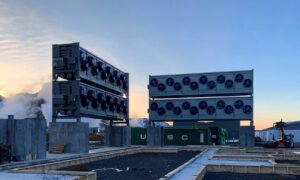Physical Address
23,24,25 & 26, 2nd Floor, Software Technology Park India, Opp: Garware Stadium,MIDC, Chikalthana, Aurangabad, Maharashtra – 431001 India
Physical Address
23,24,25 & 26, 2nd Floor, Software Technology Park India, Opp: Garware Stadium,MIDC, Chikalthana, Aurangabad, Maharashtra – 431001 India

By Aayushi Sharma
CLAIM
In fighting climate change, planting trees doesn’t make sense as it takes years for them to grow. Carbon capture machines work better.
FACT
Trees play a primary role in the functioning of the ecosystem and their role is not restricted to carbon capture. They play a crucial role in adapting to climate change and even mitigating its effects.
WHAT THEY CLAIM
The article says that forests need a permanence of about 100 years to be effective. The trees planted as a part of the afforestation drive are not known to retain and sequester considerable amounts of carbon until at least ten years. Once planted, they must be checked and maintained to ensure they don’t catch forest fire. Some experts from carbon storage companies said, “So you plant your seedlings and then you have to maintain the forest for 100 years. That’s multiple generations of people. How many companies last 100 years these days? How on earth is anyone going to afford to maintain that forest, hiring the team of people you need to do that? It doesn’t make any sense.”
The article lays emphasis on more permanent solutions like artificial carbon capture and storage methods which are claimed to be way more effective than traditional planting of trees. It suggests that artificial carbon capture methods are more effective than trees as they help in long-term carbon capture.
WHAT WE FOUND
The claim is misleading. It is evident that trees play a crucial role in adapting to climate change and even mitigating its effects. The article mentions that artificial solutions like carbon capture are more effective in long-term carbon capture; thus, they are better than afforestation. However, it should be noted that the role of trees is not limited to sequestering carbon. They play a primary role in the functioning of ecosystems directly affected by climate change.
Trees: a nature-based solution
Trees are the classical nature-based solutions. They provide many essential ecosystem services that help make our communities healthier and more resilient. Urban forests play a crucial role in helping large cities to adapt to climate change, especially by cooling urban heat islands. Trees help in mitigating and adapting to global change in a sustainable way.
The recently released IPCC’s synthesis report has highlighted that it is better to stop degrading existing forest land than to clear the forest and compensate it by afforestation practices in a different space. Another research has supported this, “Restoration of 2 million km2 of forests and wetlands would deliver 2 billion metric tons of CO2 mitigation per year, whereas avoiding their destruction across 0.1 million km2 each year could deliver 4 billion metric tons of CO2.”
Thus, better management of forest resources helps sequester carbon dioxide and maintain the better functioning of the ecosystem to combat climate change.
Carbon capture technology: Pros and cons
The carbon capture and sequestration (CCS) method involves a process in which carbon dioxide (CO₂) is captured, usually during power generation and industrial processes, and is then stored to stop its emission into the atmosphere. CCS technologies have a vast potential to reduce CO₂ emissions. Facilities that use CCS technology have been recorded to capture almost 90-100% of the CO₂ they produce.
Energy required to run
CCS technology initially focuses on sources where carbon dioxide is released in massive amounts, such as coal-fired power plants. According to thermodynamics, the lower the concentration of carbon dioxide, the more expensive it is to capture a ton of it. In the current scenario, it is possible to achieve negative emissions by co-firing excess biomass using CCS in a coal-fired power plant and capturing the CO2 along with CO2 from the coal. If carbon capture plants are installed in the areas in the absence of large-scale discharge of carbon dioxide, then the energy required to run these plants would be more than the work performed by them.
Cost of Implementation
The high cost of implementation is a significant barrier to the widespread deployment of CCS technologies. The process of capturing CO₂ can decrease both the power and efficiency of industrial plants. It also increases their water use and some additional costs due to these factors. Thus, in areas of water scarcity, the implementation of this project is not viable. Moreover, economic constraints during the installation and functioning of this technology are there in many areas. There is a mitigating risk for the investors in the initial stages of the project as much R&D is still required to be done in this area.
Transportation Challenges
Another major challenge associated with CCS technology is transporting CO₂ once it is captured. A good amount of energy is required to compress and cool CO₂ to maintain high pressure and low temperatures. It is then transported through pipelines which are further expensive to build. There is a high cost of connecting different sources to the storage area making the overall process expensive.
Hence, if we only look at carbon storage and sequestration, then definitely the artificially built carbon capture plants work wonders, but claiming that trees, our natural resources, are not effective in climate change is a myth.
According to NASA, “Currently, Earth’s forests and soil absorb about 30 percent of atmospheric carbon emissions, partially through forest productivity and restoration.” CCS technology is only helpful in sources where large amounts of carbon dioxide is emitted. It is not an alternative to trees.
References: